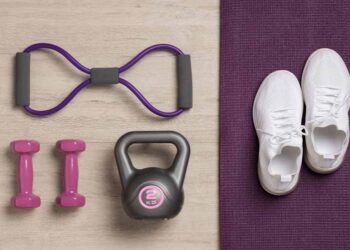Do you ever wonder how and when to take your workouts to the next level? Are you looking for exercise progression tips and techniques to optimize your fitness routine? If so, you’re not alone. Understanding the timing and strategies for advancing in your workouts is key to achieving your fitness goals. Whether you’re a beginner or a seasoned athlete, learning how to progress effectively can make all the difference in your success.
So, let’s dive in and explore the best ways to progress in your exercises. From when to progress in workouts to workout progression strategies, we’ll cover everything you need to know to revamp your workout and keep making gains.
Key Takeaways:
- Understanding exercise progression is crucial for achieving your fitness goals.
- Visible physical changes may take at least six weeks to appear, but improvements in strength and fitness can occur within two to ten weeks.
- Recognizing signs of progress, both behavior changes and physical changes, is important for staying motivated.
- Consistency, proper nutrition, and following progression strategies are key to optimizing exercise progression.
- Long-term progress requires sustaining your efforts, setting new goals, and seeking professional guidance when needed.
Signs of Progress in Your Workout
When it comes to your workout routine, it’s essential to recognize the signs of progress. These signs can be categorized into two main areas: behavior changes and physical changes.
Behavior Changes
One of the first signs of progress in your fitness journey is a positive shift in your attitude towards exercise. You may find yourself looking forward to your workouts, feeling motivated, and eager to challenge yourself. Additionally, you might notice improvements in your overall lifestyle choices, such as making healthier food choices and prioritizing self-care.
“Ever since I started my fitness routine, I’ve noticed a significant change in how I view exercise. I used to dread working out, but now I genuinely enjoy it. It has become an essential part of my daily routine, and I feel great both physically and mentally.” – Jane Smith
Physical Changes
Physical changes are also important indicators of progress in your workout routine. These changes can include weight loss, visible muscle growth, improved performance, fitting into clothes better, and enhanced sleep quality. These physical transformations serve as tangible evidence that your fitness routine is effective and that you are well on your way to achieving your goals.
For instance, John’s consistent exercise routine, which includes strength training and cardio exercises, has resulted in a noticeable reduction in his body weight, increased muscle definition, and the ability to perform exercises with greater ease.
| Signs of Progress | Examples |
|---|---|
| Weight Loss | John lost 15 pounds in the past two months. |
| Muscle Growth | Sarah can now see increased definition in her arms and legs. |
| Improved Performance | David can run an extra mile without feeling fatigued. |
| Better Fitting Clothes | Mary had to buy a smaller size for her jeans. |
| Improved Sleep Quality | Emily now enjoys better sleep and wakes up feeling refreshed. |
Recognizing and celebrating these signs of progress is vital to stay motivated and continue pushing yourself. Remember, progress is not solely measured by physical changes; it’s also about improved well-being and a positive mindset.
Tips for Progressing in Your Fitness Journey
To continue progressing in your fitness journey, it’s important to follow certain strategies and techniques. First and foremost, consistency is key. Make sure to adhere to your workout routine and schedule regular rest days for recovery. Incorporating power exercises, such as plyometric training, can help activate fast-twitch muscle fibers and improve overall fitness. High-intensity interval training (HIIT) is also beneficial for improving aerobic fitness. Increasing the frequency and duration of your workouts, but not both simultaneously, can help prevent plateauing and overtraining. Lastly, nutrition plays a crucial role in progress, so it’s important to fuel your body with proper nutrients and work with a qualified professional, such as a registered dietitian, to optimize your nutrition plan.
Strategies for Progressing in Workouts
Fitness progress requires a well-thought-out plan and strategic approach. Here are some effective strategies to optimize your exercise progression:
- Progressive Overload: Gradually increase the intensity, duration, or resistance of your workouts to challenge your body and stimulate further progress.
- Variation: Incorporate different types of exercises, such as strength training, cardio, and flexibility exercises, to target different muscle groups and prevent monotony.
- Goal Setting: Set specific and achievable goals to stay motivated and track your progress. Break down big goals into smaller milestones for a sense of accomplishment along the way.
- Proper Form: Focus on executing exercises with correct form and technique to maximize effectiveness and minimize the risk of injury.
- Rest and Recovery: Allow your body enough time to recover and repair between workouts. Incorporate rest days and prioritize sleep for optimal progress.
Ways to Improve Workout Intensity
Boosting workout intensity can help you push your limits and achieve greater gains. Here are a few tips to ramp up the intensity of your workouts:
- Interval Training: Alternate between periods of high-intensity exercise and active recovery to challenge your cardiovascular system and improve endurance.
- Supersets and Circuits: Combine multiple exercises targeting different muscle groups without taking long breaks to keep your heart rate elevated and maximize calorie burn.
- Progressive Resistance: Gradually increase the weight or resistance used during strength training exercises to continuously challenge your muscles.
- Short Rest Periods: Reduce rest periods between sets to keep the intensity high and increase the overall workload of your workout.
“Success is the sum of small efforts, repeated day in and day out.”
Remember that progress in fitness is a journey that requires patience, dedication, and the willingness to challenge yourself. By implementing these tips and techniques, you can optimize your exercise progression and make significant strides towards your fitness goals.
| Technique | Description |
|---|---|
| Progressive Overload | Gradually increasing the intensity, duration, or resistance of your workouts |
| Variation | Incorporating different types of exercises to target different muscle groups |
| Goal Setting | Setting specific and achievable goals to track progress |
| Proper Form | Executing exercises with correct form and technique |
| Rest and Recovery | Allowing enough time for rest and prioritizing sleep |

By implementing these strategies and tips for advancing in workouts, you can optimize your exercise progression, boost workout intensity, and continue making progress on your fitness journey.
The Journey Beyond One Year
Reaching the one-year mark in your fitness journey is a significant achievement, but the journey doesn’t end there. Long-term maintenance of fitness progress is crucial for sustaining your hard-earned gains and continuing to prioritize your health and fitness.
To keep progressing in your fitness journey, it’s important to periodically reassess your goals. Setting new goals and targets will keep you motivated and prevent stagnation. Whether it’s increasing strength, improving endurance, or achieving a new level of flexibility, having specific goals will guide your training and ensure continued progress.
Staying consistent with exercise is another key aspect of long-term maintenance. Make exercise a regular part of your routine, whether it’s daily, three times a week, or any other schedule that works for you. Consistency is crucial for maintaining your fitness progress and preventing regression.
Listening to your body’s needs is essential for sustaining progress. Pay attention to signs of fatigue, injury, or burnout, and adjust your training accordingly. Rest and recovery are just as important as training, so make sure to incorporate rest days and active recovery activities into your routine.
The Benefits of Variety and Cross-training
Introducing variety and cross-training into your fitness routine is a great way to challenge your body, prevent boredom, and continue making progress. By participating in different activities and exercises, you engage different muscle groups and stimulate your body in new ways. This can lead to enhanced overall fitness, improved strength, and reduced risk of overuse injuries.
Consider trying different types of workouts, such as swimming, cycling, or yoga, in addition to your regular routine. Cross-training not only keeps things interesting but also helps you build a well-rounded fitness foundation. Mixing cardio, strength training, and flexibility exercises can contribute to improved overall fitness and prevent plateaus.
Seeking Professional Guidance for Long-term Progress
As you embark on your long-term fitness journey, seeking professional guidance can be highly beneficial. Fitness professionals, such as personal trainers or exercise physiologists, can provide expert advice tailored to your specific needs and goals. They can help design a customized workout plan, ensure proper form and technique, and offer valuable insights to optimize your progress.
A qualified professional can also provide accountability, motivation, and support throughout your fitness journey. They can help you stay on track, provide guidance on adjusting your program as needed, and offer valuable tips and feedback to maximize your results.
Remember, achieving long-term fitness progress requires commitment, dedication, and a willingness to adapt. By periodically reassessing your goals, staying consistent with exercise, incorporating variety and cross-training, and seeking professional guidance when necessary, you can continue making progress and achieving new milestones in your fitness journey.
| Benefit | Description |
|---|---|
| Improved overall fitness | Variety and cross-training engage different muscle groups, leading to enhanced overall fitness. |
| Prevention of boredom | By trying different activities, you can keep your workouts interesting and enjoyable. |
| Reduced risk of overuse injuries | Engaging in different types of exercises reduces the strain on specific muscle groups, decreasing the chance of overuse injuries. |
Conclusion
Commitment to your fitness journey is the key to long-term success in achieving your health and wellness goals. It’s important to remember that progress is not just about physical changes, but also about celebrating the improvements in your mental health, sleep quality, and overall well-being. By staying consistent and motivated, you can continue the fitness journey and reach new milestones along the way.
Don’t forget to celebrate your progress, both big and small. Recognize the effort you’ve put in and the positive changes you have experienced. Whether it’s mastering a new exercise, increasing your flexibility, or breaking personal records, each achievement is worth celebrating.
As you continue your fitness journey, it’s crucial to set realistic goals and adapt your approach as needed. Seeking professional guidance when necessary can provide valuable insights and ensure you stay on the right track. Remember, everyone’s timeline for progress is unique, so focus on continually improving and challenging yourself to achieve your long-term fitness goals.














